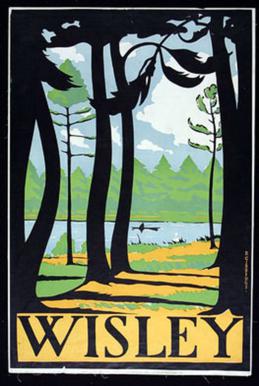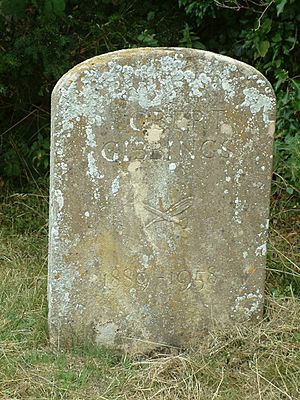Robert Gibbings facts for kids
Quick facts for kids
Robert John Gibbings
|
|
|---|---|
| Born | March 23, 1889 Cork, Ireland
|
| Died | January 19, 1958 (aged 68) |
| Nationality | Irish |
| Known for | Wood Engraving, Sculpture, Writing |
Robert John Gibbings (born March 23, 1889 – died January 19, 1958) was an Irish artist and writer. He was best known for his amazing work as a wood engraver and sculptor. He also wrote many popular books about travel and nature. Robert Gibbings was a founding member of the Society of Wood Engravers in 1920. He played a huge part in bringing wood engraving back into style in the 20th century.
Contents
Robert Gibbings: Artist and Author
His Early Life and Studies
Robert Gibbings was born in Cork, Ireland, into a well-known family. His father, Reverend Edward Gibbings, was a minister. His mother, Caroline, came from a family of historians. Robert grew up in Kinsale, where his father was a church leader.
He first studied medicine at University College Cork for three years. But he soon realized his true passion was art. He convinced his parents to let him switch. He then studied art in Cork and later at famous schools in London, like the Slade School of Art.
During World War I, he served in the army and was hurt in a battle called Gallipoli. After recovering, he went back to his art studies in London. In 1919, he married Moira Pennefather. They had four children together: Patrick, Brigid, Lawrence, and Finnbar.
Becoming a Wood Engraver
Robert Gibbings met Noel Rooke at the Central School of Art. This meeting changed his artistic path. When Gibbings asked if it was silly to try to be an artist, Rooke replied, "What else could you do?" Being an artist, especially a wood engraver, meant Gibbings often struggled with money. However, his work was always praised by critics.
His talent was noticed early on. In 1919, Studio magazine featured his engravings, including some in color. He started getting jobs for companies like Eno's Fruit Salts and Matinée cigarettes. He even created a poster for the London Underground and a booklet for the London Zoo in 1922. This booklet is now considered his first published work and is very rare.
In 1922, Gibbings designed a cover for a book called The Oppidan. The next year, he illustrated Erewhon by Samuel Butler. He was a key figure in the world of wood engraving. He helped start the Society of Wood Engravers in 1920 with Noel Rooke.
In 1922, he contributed two engravings to Contemporary English Woodcuts. A famous art expert, Campbell Dodgson, wrote about Gibbings in the book. He said Gibbings represented the "Cubist" or "Post-Impressionist" style in wood engraving. In 1923, Gibbings received a big job: to create engravings for The Lives of Gallant Ladies for the Golden Cockerel Press. This was his most important project at the time.
Leading the Golden Cockerel Press
While Gibbings was working on The Lives of Gallant Ladies, the owner of the Golden Cockerel Press became very ill. Gibbings decided to buy the press himself in 1924. He paid £850 for the business and its equipment. This marked the start of a very successful time for the press and for Gibbings.
The printing team at the press was very skilled. Gibbings's wife, Moira, also helped with the business. Gibbings knew many top wood engravers and authors. This allowed him to publish both new and classic books.
His first book as the owner was Moral Maxims in 1924. He also worked with famous artists like Eric Gill and commissioned engravings from others like John Nash and David Jones.
Gibbings published about 71 books at the press. Most books were printed in small numbers, usually between 250 and 750 copies. They were often bound in fine leather. Some of his most famous works included the four-volume Canterbury Tales (1929-1931) and the Four Gospels (1931). Both were illustrated by Eric Gill. These books were very successful and earned a lot of money.
Gibbings also created many books with his own wood engravings. Some of his best were The True History of Lucian (1927) and Lamia by John Keats (1928). Sales were strong, especially with a good deal he made with Random House in the USA.
The Gibbings family moved to Waltham St Lawrence when he bought the press. Even though he was busy with the press, Gibbings still worked for other publishers. He illustrated The Charm of Birds (1927) and A Mirror for Witches (1928).
In 1929, he got an exciting offer from Houghton Mifflin. They wanted him to illustrate a book set in Tahiti. Gibbings loved the idea and traveled to Tahiti. He created the engravings, and two books came from his trip: The Seventh Man (1930) and Iorana (1932).
In 1932, Gibbings suggested to the Orient Line shipping company that he create wood engravings for their ads in exchange for a free cruise. They agreed, and he produced XIV Engravings on Wood for them.
By the early 1930s, the economy was struggling, and book sales slowed down. Gibbings eventually sold the press in 1933. His last book produced there was Lord Adrian (1933).
Teaching and New Beginnings
After selling the press, Gibbings lost his main source of income. He moved into a small hut on the property to save money. He felt a sense of peace after clearing his debts. He wrote, "But what peace of mind when, standing in the wooden hut to which I had moved, I could look about me and see not one thing that was worth five shillings to anyone else!"
In 1934, he finished two books he considered his best: Beasts and Saints and Glory of Life. This marked the start of a long period where he wrote and illustrated his own books. In 1935, he published A True Tale of Love in Tonga, and in 1936, Coconut Island, a book for children. These were based on his travels in the South Seas.
His reputation grew, and Penguin Books asked him to write a travel book. He traveled to Bermuda and the Red Sea and wrote Blue Angels and Whales (1938). This was the first original book Penguin ever commissioned. This led to Gibbings becoming the art director for a new series of Penguin Illustrated Classics. He illustrated Herman Melville's Typee for the series. Penguin also published Coconut Island as a Puffin Story Book in 1945.
Besides writing his own books, he continued to create wood engravings for other projects. He illustrated A Book of Uncommon Prayer (1937) and designed a special telegram for the Post Office.
In 1936, Gibbings became a part-time lecturer at Reading University. He taught typography, book production, and illustration. He was a great teacher and encouraged his students. He even published books illustrated with their wood engravings, like Fatherless Oberlus (1936).
The Famous River Books
In 1940, during World War II, Gibbings's wife Elisabeth and their two children moved to Canada for safety. While they were away, Gibbings moved into a university residence hall. He enjoyed his bachelor life and his teaching job.
He started going on nature trips along the Thames river, organized by the university. He later wrote, "In the early days of 1939 there arose in me a great desire to find peace beside a river." With his son Patrick and two helpers, he built a boat called the Willow. He then floated down the Thames. This journey led to his famous book, Sweet Thames Run Softly (1940). The title came from a poem by Edmund Spenser.
His book was filled with observations and wood engravings of the countryside, the river, and its wildlife. It was written during a time of war and uncertainty, and readers loved it. It sold over 140,000 copies!
He followed this success with Coming down the Wye (1942) and Lovely is the Lee (1944). These books followed a similar style, mixing personal stories, history, and his beautiful wood engravings. In 1945, he traveled to Polynesia again, visiting many islands and spending time in New Zealand. He wrote about these adventures in Over the Reefs (1948).
He returned to Ireland for Sweet Cork of Thee (1951) and then traveled to France for Coming down the Seine (1953). Trumpets from Montparnasse (1955) was based on his travels in France and Italy. His last book, Till I end my Song (1957), was about the area around Long Wittenham. The title was the second half of the poem that inspired Sweet Thames Run Softly.
Besides writing his own books, he also illustrated others, like Charles Darwin's The Voyage of the Beagle (1956). Robert Gibbings became a familiar face on British television and his voice was well-known on the radio. David Attenborough has said that Gibbings was one of his inspirations.
In September 1955, Gibbings bought a small cottage in Long Wittenham, right by the Thames. He found peace and quiet there. He lived there until he passed away from cancer on January 19, 1958, in Oxford. He is buried in the churchyard at Long Wittenham. His grave has a simple headstone with his special symbol: a crossed quill (for writing) and a graver (for engraving).
His Artistic Legacy
Robert Gibbings was a very important figure in the modern revival of wood engraving in Britain. His career was long and very significant. He was involved in all the new developments in wood engraving, from his early abstract works to the detailed landscapes in his river books. He also ran the Golden Cockerel Press during a time when it truly defined what a beautiful wood-engraved book could be.
He loved the possibilities of wood engraving. He enjoyed the sound of the tool carving the wood and the clean, precise lines it created. He believed that this art form allowed for clear and exact statements that couldn't be achieved in any other way.




